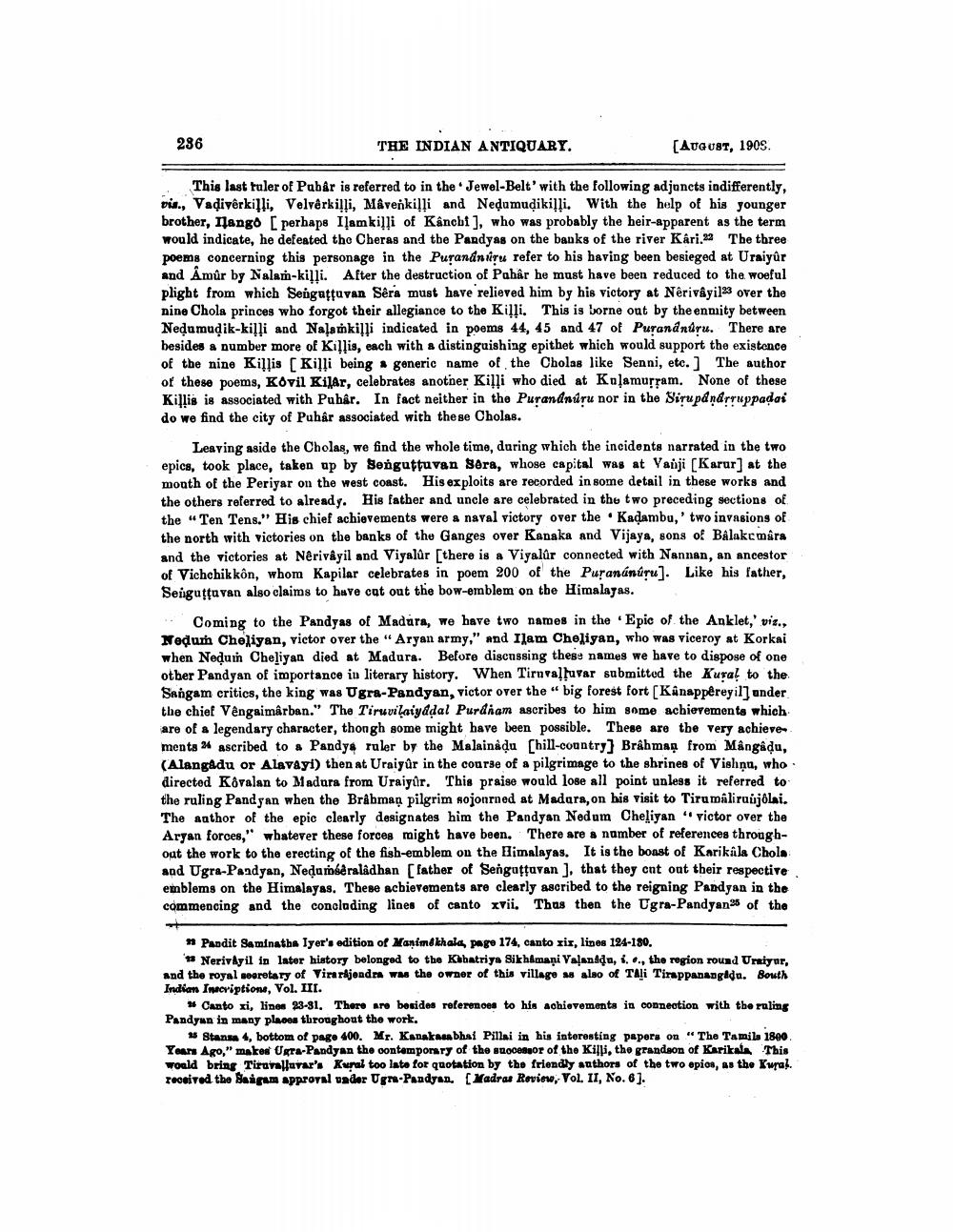________________
236
THE INDIAN ANTIQUARY.
[AUGUST, 1909.
This last ruler of Pubâr is referred to in the Jewel-Belt' with the following adjuncts indifferently, vis., Vadivêrkilli, Velverkilli, Mâvenkilli and Nedumudikilli. With the help of his younger brother, Пango [perhaps Ilamkilli of Kânchi], who was probably the heir-apparent as the term would indicate, he defeated the Cheras and the Pandyas on the banks of the river Kâri.22 The three poems concerning this personage in the Purandniṛu refer to his having been besieged at Uraiyûr and Amûr by Nalam-killi. After the destruction of Pahâr he must have been reduced to the woeful plight from which Senguttuvan Sêra must have relieved him by his victory at Nêrivâyil23 over the nine Chola princes who forgot their allegiance to the Killi. This is borne out by the enmity between Nedumudik-killi and Nalamkilli indicated in poems 44, 45 and 47 of Purandnúru. There are besides a number more of Killis, each with a distinguishing epithet which would support the existence of the nine Killis [Killi being a generic name of the Cholas like Senni, etc.] The author of these poems, Kovil Kilar, celebrates another Killi who died at Kulamuṛram. None of these Killis is associated with Puhâr. In fact neither in the Purandnúṛu nor in the Sirupándrruppadai do we find the city of Puhâr associated with these Cholas.
Leaving aside the Cholas, we find the whole time, during which the incidents narrated in the two epics, took place, taken up by Senguttuvan Sera, whose capital was at Vanji [Karur] at the month of the Periyar on the west coast. His exploits are recorded in some detail in these works and the others referred to already. His father and uncle are celebrated in the two preceding sections of the "Ten Tens." His chief achievements were a naval victory over the Kadambu,' two invasions of the north with victories on the banks of the Ganges over Kanaka and Vijaya, sons of Bâlakemâra and the victories at Nêrivâyil and Viyalûr [there is a Viyalûr connected with Nannan, an ancestor of Vichchikkôn, whom Kapilar celebrates in poem 200 of the Puranánúru]. Like his father, Seiguttuvan also claims to have cut out the bow-emblem on the Himalayas.
Coming to the Pandyas of Madura, we have two names in the Epic of the Anklet,' viz., Nedum Cheliyan, victor over the "Aryan army," and Ilam Cheliyan, who was viceroy at Korkai when Neḍum Cheliyan died at Madura. Before discussing these names we have to dispose of one other Pandyan of importance in literary history. When Tiruvalluvar submitted the Kural to the Sangam critics, the king was Ugra-Pandyan, victor over the "big forest fort [Kânappêreyil] under the chief Vêngaimârban." The Tiruvilaiydḍal Purdham ascribes to him some achievements which are of a legendary character, thongh some might have been possible. These are the very achieve ments 24 ascribed to a Pandys ruler by the Malainadu [hill-country] Brahman from Mângâḍu, (Alangadu or Alavayi) then at Uraiyûr in the course of a pilgrimage to the shrines of Vishnu, who directed Kôvalan to Madura from Uraiyûr. This praise would lose all point unless it referred to the ruling Pandyan when the Brahman pilgrim sojourned at Madura, on his visit to Tirumâliruujólai. The author of the epic clearly designates him the Pandyan Nedum Cheliyan "victor over the Aryan forces," whatever these forces might have been. There are a number of references throughout the work to the erecting of the fish-emblem on the Himalayas. It is the boast of Karikala Chola and Ugra-Pandyan, Neḍuméêralâdhan [father of Senguttuvan ], that they cnt out their respective emblems on the Himalayas. These achievements are clearly ascribed to the reigning Pandyan in the commencing and the concluding lines of canto xvii. Thus then the Ugra-Pandyan25 of the
" Pandit Saminatha Iyer's edition of Manimékhala, page 174, canto xix, lines 124-130.
Nerivayil in later history belonged to the Khatriya Sikhamani Valandu, i. ., the region round Uraiyur, and the royal secretary of Virarajendra was the owner of this village as also of Tali Tirappanangadu. Bouth Indian Inscriptions, Vol. III.
"Canto xi, lines 23-31. There are besides references to his achievements in connection with the ruling Pandyan in many places throughout the work.
15 Stanza 4, bottom of page 400. Mr. Kanakasabhai Pillai in his interesting papers on "The Tamils 1800 Years Ago," makes Ugra-Pandyan the contemporary of the suocessor of the Killi, the grandson of Karikala This would bring Tiruvalluvar's Kural too late for quotation by the friendly authors of the two epios, as the Kural. received the Sangam approval under Ugra-Pandyan. [Madras Review, Vol. II, No. 6].




